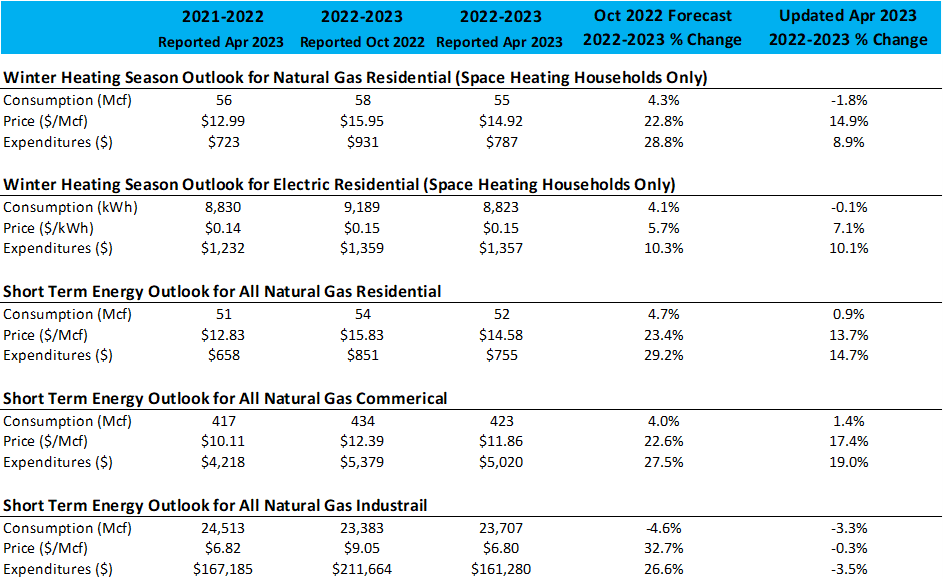Energy Insights: Winter Season Retrospective
- In October of 2022, EIA forecasted that natural gas energy bills would be, on average, $931 or 28.8% higher than what households paid last winter. During the winter, both commodity prices and seasonal weather moderated. As of April 2023, DOE’s Winter Heating Outlook reports an average winter heating bill of $787, 15.5% lower than EIA’s October forecast. Overall, residential natural gas bills were 8.9% higher in 2023 than last winter, whereas electric heating bills increased by 10.1% year over year.
- Based on the October 2022 and April 2023 EIA Short-Term Energy Outlook, all sectors have reported lower actual bills than expected since the start of the winter. For all residential households, including homes without natural gas for space heating, the average bill was 11.3% lower than forecasted. Commercial and industrial end users spent 6.7% and 23.8% less on energy bills than forecasted. The average cost to Industrials was a net 3.5% lower overall, saving the economy over $1 billion compared to last winter.
- Industrial end users realized lower energy costs this winter than previously forecasted yet consumed 1.4% more energy than expected. Residential and commercial end users reported lower consumption than expected with households and businesses using 3.7% and 2.5% less energy than forecasted.
- Separately, lower actual bills than forecasted reduced potential costs to the economy by $6.9 billion for households, $2.0 billion for commercial businesses, and $9.2 bill for industrials. Collectively, the updated forecast moderated the forecasted impact on homes and businesses by $18.1 billion.
Supplemental Materials
Changes in Actual vs Forecasted Bills for the Past Winter Season*

Source: Based on data from Energy Information Administration, Short Term Energy Outlook, October 2022, and April 2023
AGA Contact: Brendan O’Brien (bobrien@aga.org) 202-824-7220
NOTICE
In issuing and making this publication available, AGA is not undertaking to render professional or other services for or on behalf of any person or entity. Nor is AGA undertaking to perform any duty owed by any person or entity to someone else. Anyone using this document should rely on his or her own independent judgment or, as appropriate, seek the advice of a competent professional in determining the exercise of reasonable care in any given circumstances. The statements in this publication are for general information and represent an unaudited compilation of statistical information that could contain coding or processing errors. AGA makes no warranties, express or implied, nor representations about the accuracy of the information in the publication or its appropriateness for any given purpose or situation. This publication shall not be construed as including, advice, guidance, or recommendations to take, or not to take, any actions or decisions any matter, including without limitation relating to investments or the purchase or sale of any securities, shares or other assets of any kind. Should you take any such action or decision; you do so at your own risk. Information on the topics covered by this publication may be available from other sources, which the user may wish to consult for additional views or information not covered by this publication.
Copyright © 2023 American Gas Association. All rights reserved.